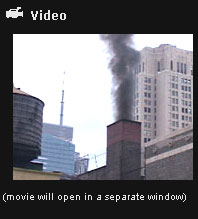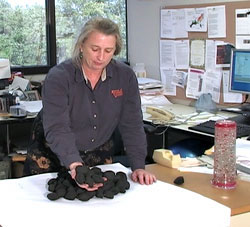Burying greenhouse gas
 The news that we're pumping twice as much carbon dioxide into the atmosphere today as we were in the 1990s gives new urgency to the problem of stopping global warming. Now two teams of scientists in the U.S. report promising results for one unique solution: burying carbon dioxide underground.
The news that we're pumping twice as much carbon dioxide into the atmosphere today as we were in the 1990s gives new urgency to the problem of stopping global warming. Now two teams of scientists in the U.S. report promising results for one unique solution: burying carbon dioxide underground.Burying Our Problems
When we look out of our windows to see entire cities teeming with cars, and realize it's hard to drive through even the countryside without seeing smokestacks, it's easy to feel like the enormity of our greenhouse gas emissions problem is beyond our control. The world's population is not, after all, about to start subsistence farming and riding bicycles everywhere. Indeed, a report released earlier this month by the World Meteorological Organization showed that our carbon emissions are rising by 2.5% annually -- more than twice the 1% annual rise that was maintained in the 1990s (which wasn't too good to begin with).
But though the situation is dire, research teams throughout the United States have been testing what they believe could be one of the viable long-term solutions: geologic carbon sequestration -- or simply burying carbon dioxide, or CO2 gas underground.
 Susan Hovorka a geologist at the University of Texas-Austin's Bureau of Economic Geology was the primary investigator on the first field test of this kind of carbon sequestration -- the Frio Brine Pilot Experiment. The Frio Site, located in Texas, is characterized by deep sandstone formations beneath denser shale rock. Back in October of 2004 her research team injected 1600 tons (or the equivalent of about 100 truckloads) of compressed CO2 about one mile underground. They've been carefully observing the site ever since, publishing their latest results in the July 2006 issue of the journal Geology.
Susan Hovorka a geologist at the University of Texas-Austin's Bureau of Economic Geology was the primary investigator on the first field test of this kind of carbon sequestration -- the Frio Brine Pilot Experiment. The Frio Site, located in Texas, is characterized by deep sandstone formations beneath denser shale rock. Back in October of 2004 her research team injected 1600 tons (or the equivalent of about 100 truckloads) of compressed CO2 about one mile underground. They've been carefully observing the site ever since, publishing their latest results in the July 2006 issue of the journal Geology."Our observations were astonishingly close to what we simulated with our model," says Hovorka, "When we stopped injection, the CO2 spread laterally for a very short period of time, a period of a few weeks, and then it stalled. And it's still there but it's not moving. I think it's permanently trapped."
 Another research team led by geologist Brandon Nuttall at the Kentucky Geological Survey of the University of Kentucky has conducted more preliminary inquiries into the possibility of injecting carbon dioxide directly into shale rock rather than considering it as a seal. Nuttall's team analyzed core samples of Devonian Black Shale from 22 locations. The shale, he explains, is very widespread, underlying two-thirds of Kentucky with similar formations under large portions of the Appalachian and Midwest States. The results of his group's tests showed that indeed, shale formations should be an effective storage location for CO2.
Another research team led by geologist Brandon Nuttall at the Kentucky Geological Survey of the University of Kentucky has conducted more preliminary inquiries into the possibility of injecting carbon dioxide directly into shale rock rather than considering it as a seal. Nuttall's team analyzed core samples of Devonian Black Shale from 22 locations. The shale, he explains, is very widespread, underlying two-thirds of Kentucky with similar formations under large portions of the Appalachian and Midwest States. The results of his group's tests showed that indeed, shale formations should be an effective storage location for CO2."Instead of being a free gas, in this space between the particles of rock the CO2 is actually stored as a thin layer that is somewhat chemically bonded to the organic matter," says Nuttall.
Though there isn't as much room in the shale to store CO2 as there could be in other kinds of rock, there are added benefits to looking into shale, even besides its abundance. Since shale is an organic-rich material it often contains large quantities of natural gas, or methane, which can actually be recovered through CO2 injection.
"This is a cost-benefit type situation where by getting rid of the CO2 you can produce additional quantities of a more green fuel – natural gas," says Nuttall.
Economic factors will indeed play a big part in any decision to start implementing geologic carbon sequestration, since right now there aren't any political incentives for companies to voluntarily absorb the cost.
"The cheapest thing to do when you burn fossil fuel is to do what we're doing now – put the waste products up the smokestack. In order to capture carbon we need a policy decision," says Hovorka.
 But even before issues of economics and policy there remain some fundamental scientific issues to clarify. Even though the injection of CO2 into the ground has already been used for many decades to enhance oil and natural gas recovery in mining, the main concerns now are to ensure that the carbon dioxide won't leak to the surface or cause problematic acidification of water (it forms a weak acid similar to carbonated soda when combined with water). However, both researchers agree that these risks are far less of a problem than continuing to dispose of carbon dioxide entirely into our atmosphere.
But even before issues of economics and policy there remain some fundamental scientific issues to clarify. Even though the injection of CO2 into the ground has already been used for many decades to enhance oil and natural gas recovery in mining, the main concerns now are to ensure that the carbon dioxide won't leak to the surface or cause problematic acidification of water (it forms a weak acid similar to carbonated soda when combined with water). However, both researchers agree that these risks are far less of a problem than continuing to dispose of carbon dioxide entirely into our atmosphere."I believe it's actually safe enough for application right now," says Hovorka. "We're just increasing our confidence at this point."
Since most proposed solutions for sequestering carbon emissions aren't forms of remediation - meaning they can't actually extract the CO2 that's already been released into the atmosphere, only capture CO2 from high density sources like power plants - the sooner policymakers and scientists find something they agree on, the sooner damage control can begin.
Hovorka's research was published in the July 2006 issue of Geology, and Nuttall's work has been presented at both national and international conferences.
by Eva Gladek
Greener News Room
Keywords:: CARBON SEQUESTRATION GREENHOUSE GAS UNDERGROUND



9:57 PM









<< Home